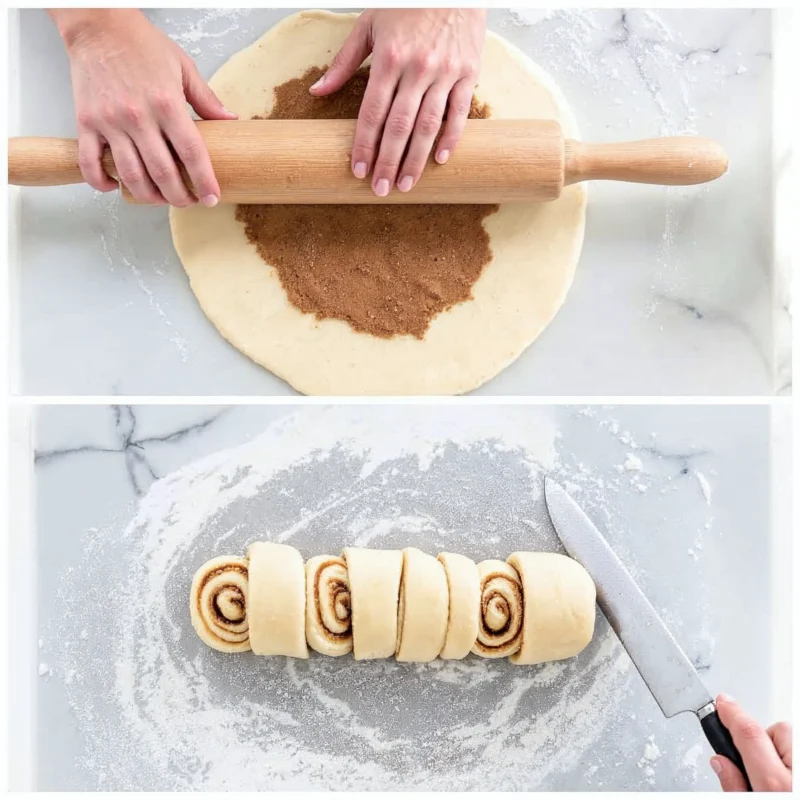Introduction
There’s something magical about the process of creating sourdough cinnamon rolls—a perfect blend of tangy sourdough and sweet cinnamon filling that’s hard to resist. Whether you’re a seasoned baker or a curious beginner, this sourdough cinnamon rolls recipe will walk you through every step to ensure success. From preparing the sourdough starter to baking fluffy, aromatic rolls, we’ve got you covered. Along the way, you’ll learn tips for troubleshooting, ways to customize your rolls, and ideas for serving. Let’s dive into the world of these delightful homemade treats!
Understanding Sourdough Cinnamon Rolls
What Makes Sourdough Special in Cinnamon Rolls?
Sourdough isn’t just for bread—it’s a game-changer for cinnamon rolls too. The natural fermentation process brings a depth of flavor and a soft, chewy texture that’s unmatched by traditional recipes. With its tangy undertone, sourdough adds a unique twist to the sweetness of cinnamon rolls, creating a balanced flavor profile.
Beyond taste, sourdough rolls are more digestible, thanks to the long fermentation that breaks down gluten and starch. This makes them a healthier option for indulgent baking.
Benefits of Using Sourdough Starter for Cinnamon Rolls
Using a sourdough starter eliminates the need for commercial yeast, relying on wild yeast and bacteria to leaven the dough. This slow, natural process not only enhances flavor but also makes the rolls stay fresher for longer. Plus, it’s a great way to use up excess starter if you’re already a sourdough enthusiast.
Another benefit? The versatility! Sourdough cinnamon rolls can be adapted for overnight proofing, making them perfect for fresh morning baking.
The Unique Taste and Texture of Sourdough Rolls
The hallmark of sourdough cinnamon rolls is their slightly tangy flavor that complements the sweet, spicy filling. The dough develops a pillowy, light texture, while still being sturdy enough to hold generous amounts of filling. When baked, these rolls are beautifully golden, with a soft, melt-in-your-mouth interior.
Preparing the Perfect Sourdough Starter
How to Make a Sourdough Starter from Scratch
Creating a sourdough starter is simpler than it seems. All you need is flour, water, and a bit of patience. Start by combining equal parts of flour and water (about 50 grams each) in a jar. Stir it until smooth, cover it loosely with a lid or cloth, and let it sit at room temperature. Over the next 5–7 days, feed your starter daily by discarding half and adding fresh flour and water in the same ratio.
As the starter ferments, you’ll notice bubbles forming, a sign that wild yeast is active. By day five, it should have a pleasant tangy smell and be ready for baking.
Feeding and Maintaining Your Sourdough Starter
To keep your starter thriving, regular feeding is key. If you bake often, keep the starter at room temperature and feed it daily. For occasional baking, store it in the fridge and feed it weekly. Before using it, bring it to room temperature and feed it at least once.
Ensure the consistency is like thick pancake batter—not too runny or stiff. Use filtered water and avoid metal utensils to preserve the natural microbes.
Signs Your Sourdough Starter is Ready for Baking
A ready-to-use starter is bubbly, doubled in size, and floats in water. This “float test” confirms that it’s active enough to leaven your sourdough cinnamon rolls recipe. If it sinks, feed it again and wait a few hours.
Step-by-Step Recipe for Sourdough Cinnamon Rolls
Preparing the Dough: Mixing and Kneading
The foundation of a great sourdough cinnamon rolls recipe starts with perfectly prepared dough. In a large mixing bowl, combine your active sourdough starter with warm milk, sugar, melted butter, and eggs. Mix until smooth, then gradually incorporate flour and a pinch of salt. The dough should be soft yet slightly sticky.
Knead the dough for about 8–10 minutes until it’s smooth and elastic. You can do this by hand or with a stand mixer using a dough hook attachment. Kneading develops gluten, which gives the rolls their structure.
First Rise: Understanding Fermentation and Proofing
Once the dough is ready, place it in a lightly greased bowl and cover it with a damp cloth. Allow it to rise in a warm spot for 4–6 hours, or until it doubles in size. This slow fermentation lets the sourdough starter work its magic, enhancing both flavor and texture.
For a detailed guide on proofing techniques, check out related tips on how to proof dough.
Making the Cinnamon Filling: Key Tips for Perfect Flavor
While the dough is rising, prepare the filling. Combine softened butter, brown sugar, and ground cinnamon in a bowl. Mix until it forms a spreadable paste. For extra flavor, add a pinch of nutmeg or cardamom.
This sweet, spiced mixture will provide the signature swirl of your rolls.
Shaping and Assembling the Rolls

Once the dough has risen, roll it out on a floured surface into a large rectangle, about 1/4-inch thick. Spread the cinnamon filling evenly over the surface, leaving a small border around the edges.
Starting from the long side, roll the dough tightly into a log. Cut it into even slices, about 1.5 inches thick, and arrange them in a greased baking dish.
Overnight Proofing for Best Results
For the fluffiest rolls, allow the shaped rolls to proof overnight in the refrigerator. Cover the dish with plastic wrap and let them rise slowly. This step deepens the flavor and allows for an effortless morning bake.
The next day, let the rolls sit at room temperature for about 30 minutes before baking.
Baking and Finishing Touches
Preheat your oven to 375°F (190°C). Bake the rolls for 20–25 minutes, or until they’re golden brown and fragrant. Be careful not to overbake; you want them soft and pillowy.
For the finishing touch, top your rolls with cream cheese frosting or a simple glaze made of powdered sugar, milk, and vanilla extract.
For more delicious recipes, check out our article on how to make bakery-style muffins.
Troubleshooting Common Issues
Why Did My Dough Not Rise?
If your sourdough cinnamon rolls recipe didn’t rise as expected, it could be due to an inactive sourdough starter. A healthy starter should be bubbly and pass the float test before use. If your starter is sluggish, give it an extra feeding and let it rest in a warm place before incorporating it into the dough.
Temperature also plays a big role. Dough ferments best in a warm environment (around 75–80°F). If your kitchen is cold, consider proofing the dough in a slightly warm oven with the light on.
How to Fix Dry or Dense Cinnamon Rolls
Dry rolls are often a result of too much flour or overbaking. When adding flour, aim for a soft, slightly sticky dough—over-flouring can make the rolls dense. During baking, keep an eye on the timer and remove the rolls as soon as they’re golden.
Adding a bit more milk or butter to the dough during mixing can also enhance moisture.
Addressing Overproofed or Underproofed Dough
Overproofing occurs when the dough rises for too long, causing it to collapse. To avoid this, monitor the dough during both rises. Underproofing, on the other hand, results in dense rolls that lack the signature fluffiness. Ensure the dough doubles in size during the first proof and looks puffy after the second.
Serving and Storing Your Sourdough Cinnamon Rolls
Serving Suggestions and Pairings

Freshly baked sourdough cinnamon rolls are best served warm, straight from the oven. Their pillowy texture pairs beautifully with a hot cup of coffee, spiced chai, or even a tall glass of milk. For a decadent twist, drizzle rolls with extra cream cheese frosting just before serving.
Hosting a brunch? Present your cinnamon rolls alongside a fruit platter or yogurt parfait for a balanced spread. These rolls are perfect for special occasions or a cozy weekend treat.
How to Store Cinnamon Rolls for Freshness
To keep your rolls soft and fresh, store them in an airtight container at room temperature for up to two days. For longer storage, refrigerate them in a sealed container for up to a week.
Freezing and Reheating Tips
To freeze, wrap the rolls individually in plastic wrap and store in a freezer-safe bag. Reheat frozen rolls in a preheated oven at 350°F for 10–15 minutes or microwave for 30 seconds to enjoy them fresh again.
Cooking Techniques for Perfect Fried Squash
Pan-Frying vs. Deep-Frying: Which is Better?
One of the most debated questions in making the perfect fried squash recipe is whether to pan-fry or deep-fry. Each method has its pros and cons, and the choice ultimately depends on your preference for texture and convenience.
Pan-Frying: This method uses less oil, making it a more economical and slightly healthier option. It involves cooking the squash slices in a shallow layer of oil in a skillet. Pan-frying allows for more control over the cooking process, ensuring even browning and a crisp exterior without overcooking the squash inside.
Deep-Frying: For those who crave an extra crispy texture, deep-frying is the way to go. Submerging squash slices in hot oil ensures a uniform crunch, making it the preferred choice for entertaining or special occasions. However, it requires more oil and a bit more cleanup.
Common Mistakes and How to Avoid Them
Making fried squash can be tricky if you’re not careful. Here are some common mistakes and how to avoid them:
- Skipping Proper Drying: Always pat the squash slices dry after washing. Excess moisture can cause the coating to slip off and make the oil splatter.
- Overcrowding the Pan: Adding too many slices at once lowers the oil temperature, resulting in soggy squash. Fry in small batches for optimal crispiness.
- Using the Wrong Oil: Choose neutral oils with a high smoke point, like vegetable or canola oil. Avoid butter or olive oil, as they can burn quickly.
- Not Seasoning Immediately: Sprinkle salt on the squash while it’s still hot to help the flavor stick.
Achieving the Perfect Crunch
For that signature crunch, focus on the coating. Use a mix of cornmeal and flour for traditional recipes, or experiment with panko breadcrumbs for added texture. Double-dip the squash slices in buttermilk and the coating mixture for a thicker, crispier crust.
With these techniques, you’ll be well on your way to mastering the art of frying squash to golden perfection.
Variations and Customizations
Making Vegan Sourdough Cinnamon Rolls
Transform this sourdough cinnamon rolls recipe into a vegan-friendly treat by making a few simple swaps. Use plant-based milk like almond or oat milk instead of regular milk. Substitute butter with vegan butter or coconut oil, and replace eggs with flaxseed meal or applesauce. The result? Fluffy, flavorful cinnamon rolls that everyone can enjoy!
Adding Nuts, Fruits, or Chocolate to Your Recipe
Elevate your cinnamon rolls by incorporating creative add-ins:
- Nuts: Chopped pecans or walnuts add a delightful crunch.
- Fruits: Raisins, dried cranberries, or diced apples bring natural sweetness.
- Chocolate: Sprinkle mini chocolate chips into the filling for a gooey, indulgent twist.
Using Different Spices for Unique Flavors
While cinnamon is the star, don’t shy away from experimenting with other spices like cardamom, nutmeg, or ginger. These spices can give your rolls a warm, aromatic flair, making them perfect for holidays or special gatherings.
FAQs About Sourdough Cinnamon Rolls
Why Are My Sourdough Cinnamon Rolls Not Fluffy?
If your sourdough cinnamon rolls are dense, the most likely culprit is underproofing. Dough needs enough time to rise and develop air pockets for a fluffy texture. Make sure the dough doubles in size during both the initial rise and the final proof. Using a weak sourdough starter can also lead to dense rolls—ensure your starter is bubbly and active before baking.
What Not to Do With Sourdough?
Avoid rushing the fermentation process. Sourdough relies on time to develop its flavor and structure. Also, don’t overflour the dough—it should be slightly sticky. Finally, avoid overproofing, as it can cause the dough to collapse during baking, ruining its texture.
Which Flour Is Best for Cinnamon Rolls?
For soft, fluffy rolls, all-purpose flour or a combination of all-purpose and bread flour works best. The moderate protein content strikes a perfect balance between tenderness and structure.
Why Is Homemade Sourdough Healthier?
Homemade sourdough is healthier because it undergoes natural fermentation. This process breaks down gluten, making it easier to digest, and increases nutrient availability. It’s free from preservatives, giving you a cleaner, more wholesome treat.
Conclusion
Sourdough cinnamon rolls are a delightful combination of tangy sourdough flavor and sweet cinnamon indulgence. By following this comprehensive guide, you’ll master everything from preparing a robust sourdough starter to baking the fluffiest rolls imaginable. With tips on troubleshooting, creative customizations, and answers to common baking questions, this sourdough cinnamon rolls recipe is your go-to resource for success.
Whether you’re enjoying these rolls fresh out of the oven, experimenting with vegan variations, or freezing them for later, they’re bound to become a favorite in your baking repertoire. Plus, knowing that sourdough offers health benefits makes each bite even more satisfying.
For more inspiration and recipes, check out our guide on how to create bakery-style muffins and other homemade delights. Happy baking!




